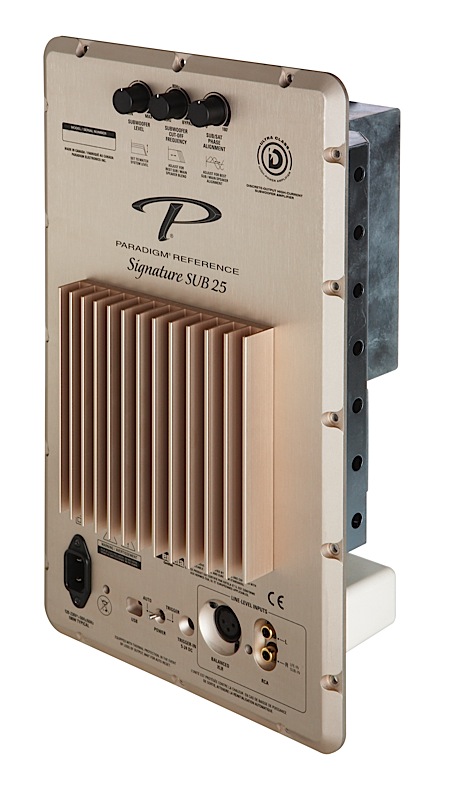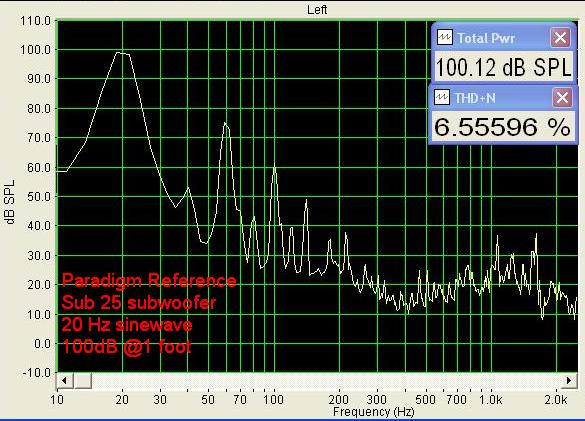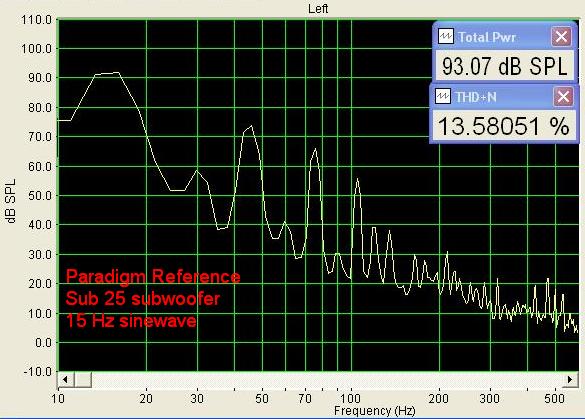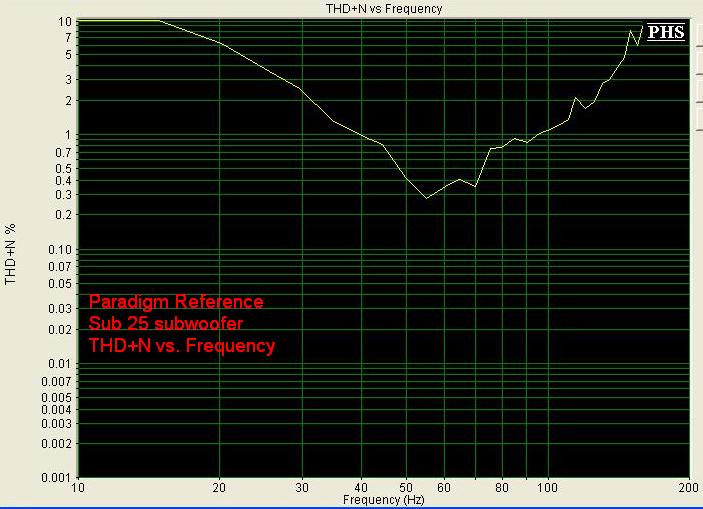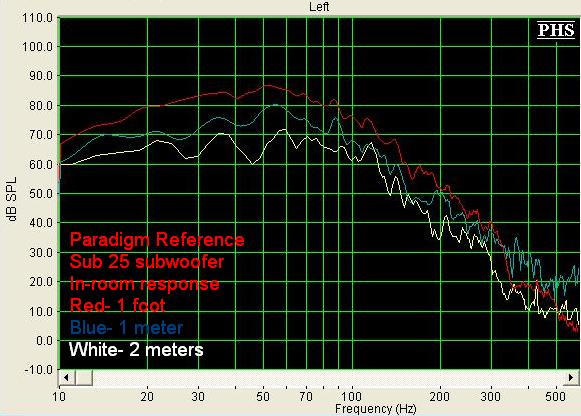
Introduction
Not so long ago, the word subwoofer meant one thing: a squat, black cube-shaped box sitting in the corner of your listening room. These days, subwoofers are made to fit in walls, ceilings, floors, even tucked under a couch. There are cylinder-shaped subs, wireless subs, and itsy-bitsy subs sure to please the wife. But there will always be a place in the hi-fi world for the mega-sub, the Beast, the Mother-of-All-Subwoofers.
That’s what Paradigm had in mind when it designed the Paradigm Reference Sub 25, at $3,999 its newest top-of-the-line subwoofer. Paradigm, the highly respected Canadian A/V company with its considerable in-house engineering and manufacturing capabilities, set out to build a no-compromise subwoofer that will play loud, deep and clean. Leveraging the expertise of sister company Anthem and its ARC room correction/equalization software, it also created the Perfect Bass Kit ($299), designed specifically for Paradigm Reference subwoofers.
So I took the nice crystal down off the shelf, tightened the tot-locks on the cabinet doors, and settled down to business.
Specifications
- Reference Signature Sub 25 Subwoofer
- Driver: One 15″
- Amplifier: CLass D, 3,000 Watts RMS
- Low Pass Filter: 35 Hz – 150 Hz, Continuously Variable, with Bypass
- Dimensions: 20.1″ H x 18.1″ W x 21.6″ D
- Weight: 114 Pounds
- Finishes Available: Piano Black, Natural Maple, Cherry
- MSRP: $3,999 USA
- Perfect Bass Kit (PBK-1) Room EQ Software
- MSRP: $299 USA
- Paradigm
The Design
The Sub 25 is a sealed-enclosure with a 15″ driver. The cone is made of mineral-filled co-polymer polypropylene with dual-spiders. The three-inch, eight layer voice coil uses a 37 pound ceramic/ferrite magnet motor structure (which goes a long way towards explaining why the beast weighs 114 pounds/51.7 kilograms). Paradigm explains that “due to the incredibly high power and tremendous output the SUB 25’s grille is non-removable.” At first I thought that was a forgivable piece of marketing fluff. However, while bench testing the Sub 25 I had to dampen two separate wall-hangings that started buzzing when I cranked the Paradigm that had never previously made a peep.
The Sub 25, like most high-powered subwoofers, is powered by a Class D amplifier that Paradigm describes as a patented Ultra-Class-D power isolation amplifier. The amp is rated at a monstrous 7,500 watts peak dynamic power, with 3,000 watts RMS sustained. The Sub 25 has a Universal Input power feature that allows it to operate at any voltage between 108 and 265 volts. Paradigm recommends that to achieve maximum performance the Sub 25 should be connected to a 240-volt line, or if a U.S. standard 120 volt line is used that the sub have its own dedicated 20-amp circuit. Unfortunately, my home has neither of those features, so the best I could do was connect it to a 15-amp circuit and keep all the other electrical devices on that circuit (except lighting) turned off. Even so, when I plugged in the Sub 25 the lights in the room noticeably dimmed.
The review sample came in gorgeous piano black, although the Sub 25 is also available in cherry or natural maple finish. As expected from a Paradigm Reference product, fit n’ finish were superb. The Sub 25 is somewhat trapezoidal shaped, with tapered sides that eliminate any parallel surfaces that could create troublesome internal resonances.
The rear panel of the Sub 25 contains a volume knob (which I never dared turn more than halfway up); a defeatable low-pass filter variable between 35 and 150 Hz, and phase adjustment knob variable between 0 and 180 degrees. The Sub 25 has two RCA line-level inputs, as well as a balanced XLR input. Other than an on-auto switch and power cord connection, the only other connection on the back panel is a USB port.
This is where the Perfect Bass Kit comes in. As many audiophiles know, Paradigm is the sister company of Anthem, maker of high-end products like the Statement pre-pros. Anthem has its own proprietary room correction/EQ software called ARC. A version of ARC designed specifically for Paradigm subs is called the Perfect Bass Kit, the PBK-1. The PBK-1 includes a software based interface that installs on your computer, along with an individually calibrated microphone and a heavy-duty cast iron microphone stand that would feel at home on any nightclub stage.
I’m a big fan of room correction software for bass frequencies, since most serious problems involve standing waves that create nulls and peaks in the 20-100Hz range. However, most existing solutions have two limitations: They only measure and calibrate response at a single room position, and address only peaks by lowering offending frequencies (attempting to overcome a room null by boosting EQ is a good way to blow up a subwoofer). The PBK-1 addresses both of these problems.
Once the software was loaded into my laptop (fast and painless), I opened the program, connected the USB calibrated microphone to my computer, and connected the supplied USB cable between my laptop and the Sub 25. The program asks you to select at least five different measurement points in your listening room, and will measure up to ten different locations. One PBK-1 will adjust up to four Paradigm Reference subs. The ability to measure in multiple room locations is particularly important in bass response, because nulls and peaks can vary dramatically in various spots, often within a couple feet of each other. The PBK-1 takes into account the various nulls and peaks in the five (or more) listening positions, and creates a suggested correction to provide the best overall sound throughout the room.
Once the software has crunched the numbers from the test tones, it shows three frequency response curves. The red line (measured without any correction applied ) showed what I already knew, that my room had a serious null (the non-technical term for which is “suck-out”) at about 50 Hz, and a boomy peak around 70 Hz. I have bass traps in my corners and acoustic treatments elsewhere, but could not do anything more with those two room modes short of knocking out and moving an entire wall.
The blue dotted line shows the target curve, what the PBK-1 would try to emulate through a series of EQ adjustments cutting and boosting targeted frequencies. Because the PBK-1 is designed to work with Paradigm Reference subs, it can boost frequencies up to certain limits to flatten out the room response without creating distortion or overdriving the amplifier. The blue line shows the frequency response after applying EQ, and the picture tells the story. The 50 Hz null and 70 Hz peak are essentially gone, with frequency response between 22 and 100Hz within 2 decibels. Most impressive!
Once the curve is set, you simply unplug the microphone and USB cables and are ready to rumble.
In Use
The first words sung on Genesis’ A Trick of The Tail album (SACD) are “Holy Mother of God,” which not coincidentally was my first reaction on hearing the Sub 25 reproduce the Moog Taurus bass pedals on the opening track, Dance On A Volcano. As Genesis bassist Mike Rutherford stomped on the bass pedals throughout the song, the Sub 25 filled the room with clean, deep bass. The best subs can actually sneak up on the listener when reproducing low frequency music, because unlike less-worthy subwoofers that slam you in the chest with a first harmonic that is masquerading as the fundamental, they accurately reproduce the fundamental in a way that is often felt rather than heard.
For example, while I was listening to Virgil Fox’s direct-to-disc recording of Bach’s “Toccata and Fugue in D Minor”, my teenage son sitting next to me (used to hearing subwoofers showing off how loud they can make a 60 Hz explosion seem) commented that he didn’t think it sounded all that impressive. I told him to stand up and walk a couple steps behind the couch, where he could feel the entire room rumbling from the pedal stops. “OK, that’s impressive,” he said. That experience was repeated numerous times, where the Sub 25 was so effortlessly reproducing low bass that it didn’t seem that loud, until I walked into another room and felt the vibration under my feet. An important note here is that our ears are not very sensitive to the lowest frequencies, so when I say that it didn’t seem that loud, the implication is that the sub was producing the sound with very low distortion. If it had seemed loud, what we would actually been noticing would be harmonic distortion.
Switching back to A Trick of The Tail, the bass accompaniment on the song Squonk consists almost entirely of bass pedal stops. Again, the Sub 25 was teasingly subtle in reproducing the notes without any boomy overtones or harmonics that are often mistaken for “loud” bass. I was satisfied that the Sub 25 could play low, but could it play loud? For that, we turn to the cinema show.
I ran through the usual assortment of movies with exploding depth charges, pod races and Darla tapping on a fish tank, but my new favorite subwoofer demo is the finale of V for Vendetta, when (spoiler alert!) Parliament is destroyed by copious quantities of high explosives and fertilizer. It may not be the lowest or loudest bass on anyone’s chart, but we’re not simply talking about one loud boom; this is an extended scene of room-shaking mayhem. There is really no good way to describe in words what the Sub 25 sounded like during this scene, just that I have never heard anything like it before.
On the Bench
All bench tests were performed with the Sub 25 in the middle of the listening room, to avoid interaction with corners or walls. Except as noted below, measurements were taken from 1 foot at a height equal to the center of the speaker grille.
Distortion at 20 Hz and 100 decibels was a very good 6.5%.
Subwoofer output is generally considered clipping at 10% distortion; I wanted to see how much I could get from the Sub 25 at 20Hz before reaching the limit. How about 108 decibels at 20Hz? Keep in mind, that was measured mid-room without any benefit from wall or corner placement, which typically adds between 3-6 decibels of useable output.
Below is the graph for THD+N vs. Frequency. It was set at 100 dB output at 50 Hz at 1 foot, then the test was started. At 15 Hz, while technically clipping at 13.5% THD+N, the Sub 25 produced a robust 93 decibels with no audible distortion or distress. Paradigm’s product sheet for the Sub 25 states “low frequency extension 9 Hz (DIN),” but I could not reproduce usable output at or below 10 Hz during my bench tests. To summarize, the subwoofer stayed below 5% THD+N from 23 Hz to about 160 Hz, which is excellent.
As noted above, the Sub 25 was technically clipping (10%) from 10-15Hz, with distortion of about 6% at 20Hz before dropping off at higher frequencies
Frequency response is shown at one foot (red), one meter (blue), and two meters (yellow). Notice how flat the response curve performance stays even as the measurements are taken farther away from the sub. That is excellent performance.
Conclusions
In the rarified world of top-of-the line subwoofers, the Paradigm Reference Sub 25 is a worthy contender. It is capable of tremendous output, low frequency extension and accurate reproduction of both music and movies. Combined with the PBK-1 EQ/Room correction software, it provides amazingly flat frequency response from any seat in the house. If you’ve got the means (about $4,300 for the combined system), it will not leave you wanting.



